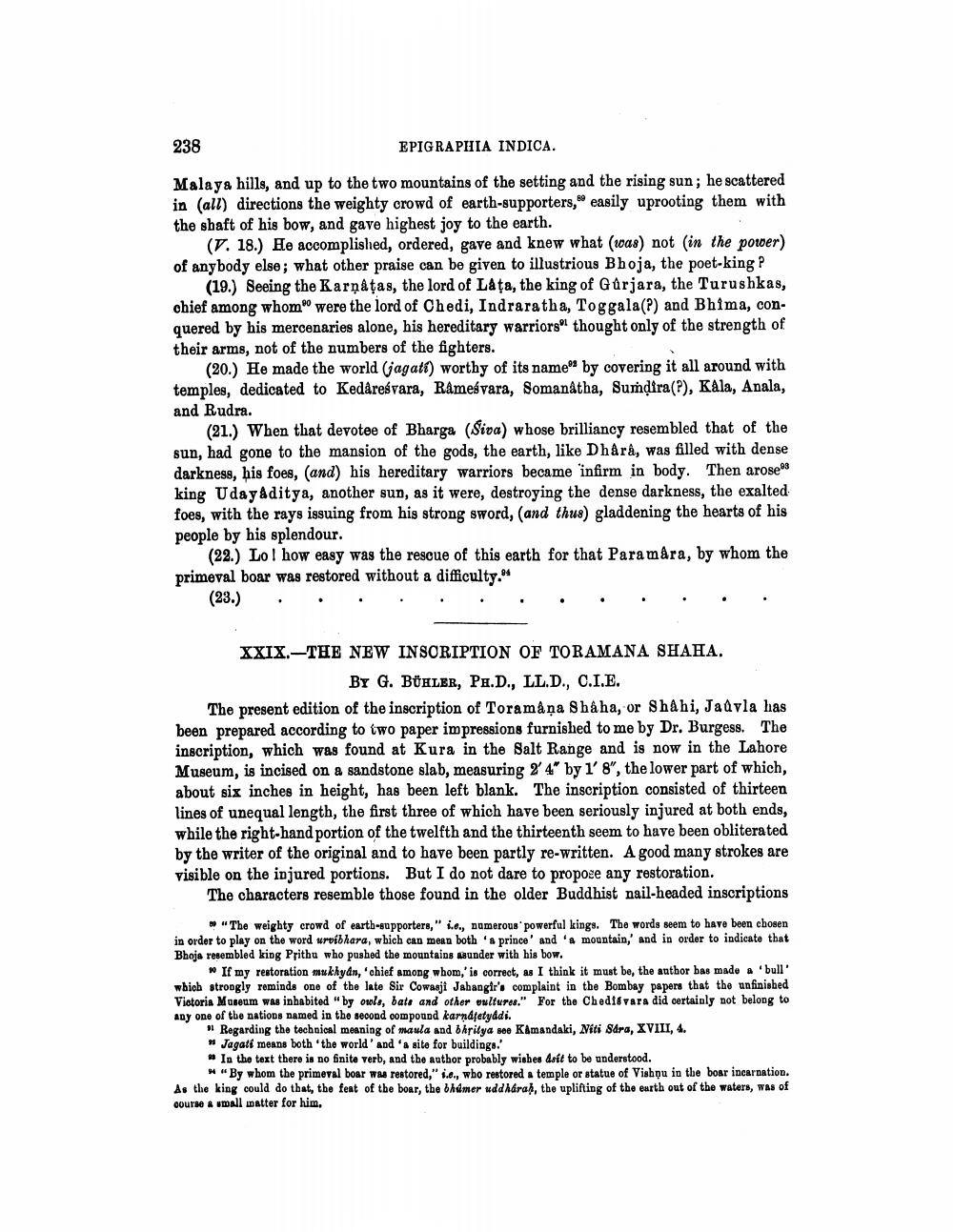________________
238
EPIGRAPHIA INDICA.
Malaya hills, and up to the two mountains of the setting and the rising sun; he scattered in (all) directions the weighty crowd of earth-supporters, easily uprooting them with the shaft of his bow, and gave highest joy to the earth.
(V. 18.) He accomplished, ordered, gave and knew what (was) not in the power) of anybody else; what other praise can be given to illustrious Bhoja, the poet-king ?
(19.) Seeing the Karnatas, the lord of Lata, the king of Gurjara, the Turushkas, chief among whom were the lord of Chedi, Indraratha, Toggala(?) and Bhima, conquered by his mercenaries alone, his hereditary warriors" thought only of the strength of their arms, not of the numbers of the fighters.
(20.) He made the world (jagatt) worthy of its name by covering it all around with temples, dedicated to Kedaresvara, Ramešvara, Somanátha, Sundira(C), Kala, Anala, and Rudra.
(21.) When that devotee of Bharga (Siva) whose brilliancy resembled that of the sun, had gone to the mansion of the gods, the earth, like Dhara, was filled with dense darkness, his foes, (and) his hereditary warriors became 'infirm in body. Then arose king Udayaditya, another sun, as it were, destroying the dense darkness, the exalted foes, with the rays issuing from his strong sword, and thus) gladdening the hearts of his people by his splendour.
(22.) Lol how easy was the rescue of this earth for that Para mára, by whom the primeval boar was restored without a difficulty."
(23.) . . . .
XXIX.-THE NEW INSCRIPTION OF TORAMANA SHAHA.
BY G. BÜHLER, PH.D., LL.D., C.I.E. The present edition of the inscription of Toramâņa Shaha, or Shahi, Jadvla has been prepared according to two paper impressions furnished to me by Dr. Burgess. The inscription, which was found at Kura in the Salt Range and is now in the Lahore Museum, is incised on a sandstone slab, measuring 24" by 1' 8", the lower part of which, about six inches in height, has been left blank. The inscription consisted of thirteen lines of unequal length, the first three of which have been seriously injured at both ends, while the right-hand portion of the twelfth and the thirteenth seem to have been obliterated by the writer of the original and to have been partly re-written. A good many strokes are visible on the injured portions. But I do not dare to propose any restoration.
The characters resemble those found in the older Buddhist nail-headed inscriptions
"The weighty crowd of earth-supporters," Le, namerous powerful kings. The words seem to have been chosen in order to play on the word urvíbhara, which can mean both 's prince' and 's mountain,' and in order to indicate that Bhoja resembled king Pritha who pushed the mountains sunder with his bow.
If my restoration mukhydn, chief among whom,' is correct, as I think it must be, the author has made a 'bull' which strongly reminds one of the late Sir Cowasji Jahangir's complaint in the Bombay papers that the unfinisbed Victoria Museum was inhabited by owla, bata and other uultures." For the Chedisvara did certainly not belong to Any one of the nations named in the second compound karndfatyddi.
Regarding the technical meaning of maula and bhritya seo Kamandaki, Niti Sara, XVIII, 4. # Jagati means both the world' and 'a site for buildings.
In the text there is no finita verb, and the author probably wishes doft to be understood.
# "By whom the primeval boar ww restored," i..., who restored a temple or statue of Vishnu in the boar incarnation, As the king could do that, the fent of the boar, the bhümer uddháraḥ, the uplifting of the earth out of the waters, was of course a small matter for him.




